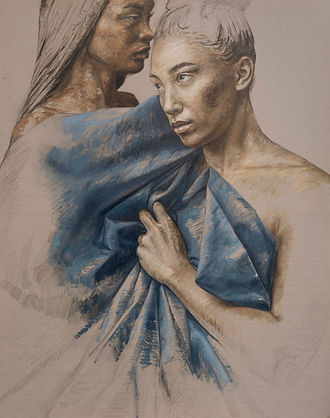

Uitstalling Kube
Lionel Smit
Veil
July 2 - October 1, 2023
VEIL
Smit’s solo exhibition - Veil -showcases his masterful fusion between the use of Classical art techniques and a profound exploration of the hidden aspects of our existence. The theme represents the veiled - the unseen world that exists just beyond the grasp of our physical senses.
Featuring a new series of oil paintings and a collection of bronze sculptures, the show exemplifies Smit's mastery in translating his artistic vision across various mediums and offers a harmonious dialogue between painting and sculpture.

Uitstalling Art Gallery ©

Uitstalling Art Gallery ©

Uitstalling Art Gallery ©

Uitstalling Art Gallery ©

LIONEL SMIT
Lionel Smit is one of South Africa’s most prolific and exalted artists. His artistic diversity is pursued through a variety of mediums and he is best known for his contemporary portraiture. His art is defined by a deeply rooted symbiotic relationship between sculpture and painting. Today, each of Lionel Smit’s works offers us an entry point into the variety and richness that lies beneath every face we encounter in life, whether applied in bronze or paint. The blending of techniques across genres is a display of Smit’s work in multiple media, all bearing a visible and tangible overlap.
Lionel Smit was born in 1982 in Pretoria, South Africa. Smit’s work has been the subject of several solo exhibitions, his painting Kholiswa has been exhibited at the National Portrait Gallery in London receiving the Viewer’s Choice Award. Collections including his works vary from Standard Chartered Bank to Laurence Graff Art Collection and his painting has been featured on the cover of Christie’s Auction Catalogue.

Shrouded Intimacy
Essay by Prof Ernst van der Wal, Department of Visual Arts, Stellenbosch University
In gentle folds, shimmering creases and billowing sweeps, we see the body swathed in layers of lush fabric. The veil – an article of clothing that is steeped in historical significance – is used by Smit to contemplate ways in which the human body is revered, admired and protected.
As counterfoil to earlier projects in which Smit explored themes ranging from exposure to the contemporary consumption of manipulated images, Veil showcases a body of work in which he returns to some of his earlier artistic roots and sources of inspiration. Reference is made to the work of Caravaggio and Titian, who used veils to examine and question some of the religious ideas held at the time. Smit plays with the symbolic suppleness that veils have long offered such artists – veils cover, protect and disguise but, in turn, can also be used to suggest, intimate and reveal. We also see allusions to the modelli or cartoons produced by Raphael, who used rough oil sketches to plan and prepare for his larger work. Smit strategically harnesses such stylistic references to acknowledge the richness of the art historical canon from which he continues to draw. Like overlapping veils, we encounter different histories and practices layered over one another.
n some of his paintings, we see nebulous clouds and dramatic lighting mirroring the theatrical effect of the veil. His sculptural work picks up on some of these qualities with various shapes and textures carefully layered so as to create the illusion of a face in flux. Each of the carefully modulated figures carries their likeness in idiosyncratic traces and marks, with quiet, pensive faces emerging in strips, circles and smudges.
As Paul Hills maintains, shrouds and veils carry sacral connotations that endure within more contemporary environments. Acting as a membrane between different worlds, veils hint at the presence of something or someone that is held in such high regard that some separation is needed to keep the everyday at bay. Veils, Hills contends, are suggestive of intimacy, theatricality and fantasy, and they provide the symbolic material with which we tell stories about our own desires. Veils form part of “a visual culture of performance [and] spectatorship,” as they are “worn, touched, given in dowries, stored in chests, paraded on the person or separated from the body” (Hills 2006: 780). Especially in a European context, customs of veiling are largely associated with ritualised performances of covering and uncovering, disguise and revelation. In this way, veils facilitate movement between states of concealment and exposure. As much as they hide and shield, veils also ask to be seen, touched, and sometimes even lifted.
Sources cited: Paul Hills, 2006. ‘Titian’s Veils’, in Art History. Volume 29, Issue 5.



















